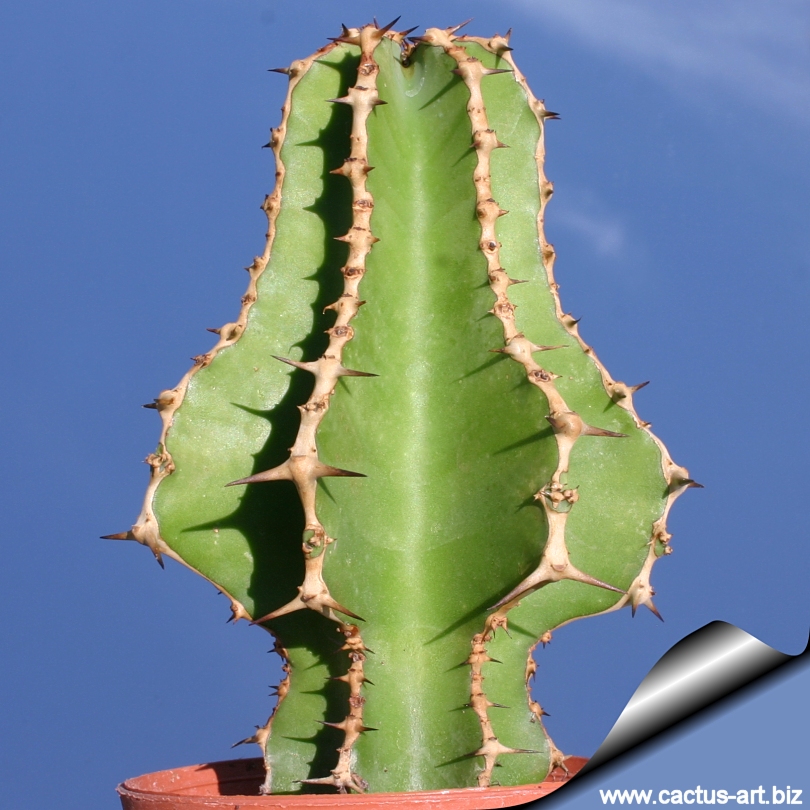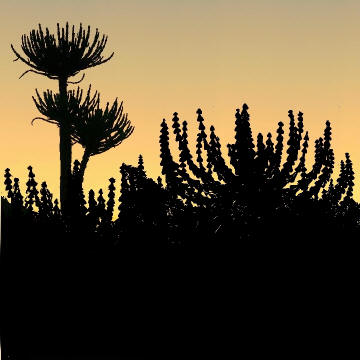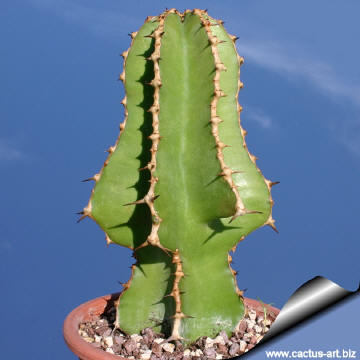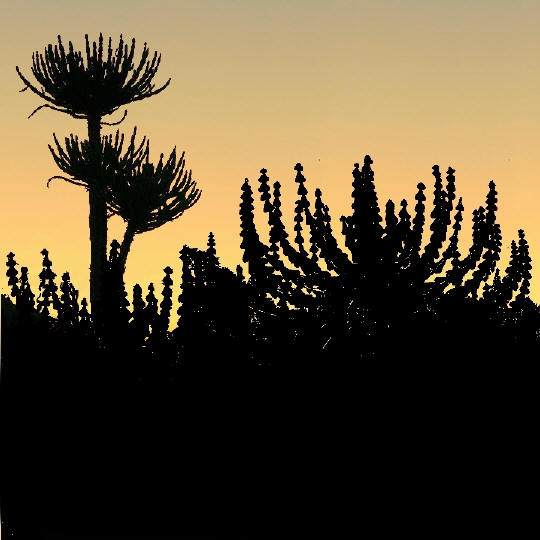|
|
|

Euphorbia cooperi is one
of the most beautifull of all tree-like euphorbia, characterized by
periods of rapid growth, designated by the wide sections, and minimal
growth which are the narrow sections.
|
|
Description: Euphorbia
cooperi is a spiny, succulent tree 4-7 m tall, with conspicuous
candelabra-like branches. The branches do not split again, unlike the
common tree Euphorbia. Old dead branches hang underneath the the compact
crown for a while. Over time all lower branches sheds in a continual
process leaving the top branches to accentuate the candelabra form.
Stem: The solitary trunk is naked, straight, grey to dark grey or
brown with a gnarled appearance up to 5 m high. Round holes on the trunk
indicate where old branches have fallen off. Branches are bright green
or yellow-green even thought times of drought, conspicuously 4 to 6
winged with characteristic narrowing and widening and rounded tops like
those on a some Mid-eastern building or a chunky string of beads. The
triangular or heart-shaped segments are 50-150 x 120 mm.
Spines: The spines form a spiky margin along each ridge on the
branches. Spines are found in pairs and are usually 5 to 7(-15) mm long.
The outer rib-ridges have continuous, narrow and dark spine shields
running along them.
Leaves: No clearly visible, very small, inconspicuous that fall
early, they are sometimes seen on the branch ridges among the spines.
Flowers: Yellowish green, small (4 mm) bisexual, sessile, arranged in 3
parallel rows along the ridges between the spines towards the tips of
the branches . They are clustered in cymes each with by 3 cyathia with
the male flowers at the tip in the centre of the row, and the bisexual
flowers below on the outside.
Blooming season: Spring to summer.
Fruit: The fruit is a large 3-lobed berry-like capsule, 15 x 8 mm
long and green in colour with red markings that changes from red to
purple when ripe. When mature, they burst open, flinging individual
seeds several meters away. The fruit is eaten by birds.
Fruiting season: From spring onwards and overlap with the
flowering time.
|

For its beauty and distinctive silhouette nearly all the botanical gardens
have one. |

The outer rib-ridges have continuous, narrow and dark spine shields
running along the paired spines.ì |
|


Advertising
|
|
|
|
|
|
|
Family: Euphorbiaceae
Accepted
scientific name: Euphorbia cooperi
N.E.Br. ex A.Berger
In: Sukk. Euph.: 83 (1907); NE Br. in Fl. Cap. 5(2):
368 (1915)
Common English Names include:
Lesser Candelabra Tree, Transvaal
Candelabra Tree, Bushveld candelabra euphorbia
Origin: South Africa (KwaZulu-Natal , Mpumalanga; Gauteng,
Swaziland and up to Messina in Limpopo)
The varieties cooperi,
calidicola and ussanquensis have been
described; only the first one occurs in South Africa, the others are
found to the north in other African countries ( Zimbabwe, Zambia,
Mozambique, Botswana, Tanzania; Malawi )
Habitat: This tree prefers well-drained
soils and is mostly found in rockier places, often on granite outcrops
and in rock cracks or in wooded grassland and thorny scrubland. In
planes and in steep hillsides on north-facing slopes.
Conservation status: Listed in
CITES appendix 2.
|
|
|
|

Euphorbia cooperi, is a classic succulent candelabra tree with a tall
erected trunk crowned with a whorl of jointed branches.
Cultivation: It is an easy species to grow that is suited for any
well drained soil in full sun. But young plant are happy growing
indoors. Give the plant an airy growing medium which mainly consists of
non organic material such us clay, pumice, lava grit, and only a little
peat or leaf-mould. Water regularly during the active growing season
from March to September. No water should ever be allowed to stand around
the roots. Keep almost completely dry in winter. It is a moderately fast
grower, and will quickly become large landscape masterpieces in just
5-10 years. Only downside is from strong winds, the columns often smash
into each other, causing permanent scarring... best to plant in such a
location where winds are not a big issue. It is a long lived plant
and once established, it will be content in its position and with its
soil for years. It can tolerate moderate shade, and a plant that has
been growing in shade should be slowly hardened off before placing it in
full sun as the plant will be severely scorched if moved too suddenly
from shade into sun. Like quite small pots, repot in very later winter,
early spring. Frost tender, frost free zones only.
Propagation: It is
easy to propagate by cuttings in late spring to summer, just take
a cutting of the plant let it dry for 1 or 2 weeks and stuff it in the
ground (preferably dry, loose, extremely well draining soil).
Warning: Its latex is
reputed the most poisonous in all of the species. Can irritate the skin
even if there is proximity and no actual contact, a slight smear on the
skin or face produces blisters and inhalation of the air close to a
bleeding plant can produce a burning sensation in the throat. Latex
irritates the eye and can cause blindeness. If contact is made with this
white sap, take care to not touch face or eyes before washing hands with
soap and water.
Traditional uses:
Fishing: It is used to stupefy fish, making it possible to catch
them by hand. The fish poison is prepared by soaking a bundle of grass
in the latex, tying it to a stone and throwing it into the water.
Paralysed fish rise to the surface within a short period of time.
Gardening: This tree can be grown in large, rocky, well-drained
soil in gardens in drier areas, however, because of the latex and
spines, is not advisable for a family garden. It is very drought
resistant but susceptible to frost. |
|